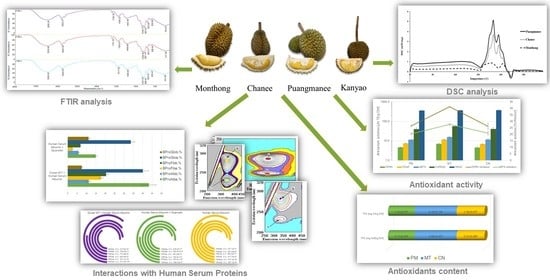Properties of Different Varieties of Durian
Abstract
1. Introduction
2. Materials and Methods
2.1. Chemicals and Materials
2.2. Sampling
2.3. Determination of Physicochemical Properties
2.4. Determination of Bioactive Compounds
2.5. Determination of Antioxidant Capacities
2.6. Fourier Transform Infrared Spectrometry (FTIR) and Differential Scanning Calorimetry (DSC) Measurements
2.7. Fluorometric Studies
2.8. Data Analysis
3. Results and Discussion
3.1. Physicochemical Properties
3.2. Determination of Bioactive Compounds
3.3. Antioxidant Properties of Durian Cultivars
3.4. Fourier Transform Infrared Spectroscopy (FTIR) and Differential Scanning Calorimetry (DSC) Studies
3.5. Binding Properties of Phenolic Properties of Durian Cultivars with Human Serum Proteins
4. Conclusions
Author Contributions
Funding
Institutional Review Board Statement
Informed Consent Statement
Data Availability Statement
Acknowledgments
Conflicts of Interest
References
- Ali, M.M.; Hashim, N.; Abd Aziz, S.; Lasekan, O. Exploring the chemical composition, emerging applications, potential uses, and health benefits of durian: A review. Food Cont. 2020, 113, 107189. [Google Scholar] [CrossRef]
- Poovarodom, S.; Haruenkit, R.; Vearasilp, S.; Namiesnik, J.; Cvikrova, M.; Martincova, O.; Ezra, A.; Suhaj, M.; Ruamsuke, P.; Gorinstein, S. Comparative characterization of durian, mango and avocado. J. Food Sci. Technol. 2010, 45, 921–929. [Google Scholar] [CrossRef]
- Gorinstein, S.; Haruenkit, R.; Poovarodom, S.; Vearasilp, S.; Ruamsuke, P.; Namiesnik, J.; Leontowicz, M.; Leontowicz, H.; Suhaj, M.; Sheng, G.P. Some analytical assays for the determination of bioactivity of exotic fruits. Phytochem. Anal. 2010, 21, 355–362. [Google Scholar] [CrossRef] [PubMed]
- Charoenkiatkul, S.; Thiyajai, P.; Judprasong, K. Nutrients and bioactive compounds in popular and indigenous durian (Durio zibethinus Murr.). Food Chem. 2015, 193, 181–186. [Google Scholar] [CrossRef] [PubMed]
- Isabelle, M.; Lee, B.L.; Koh, W.; Huang, D.; Ong, C.N. Antioxidant activity and profiles of common fruits in Singapore. Food Chem. 2010, 123, 77–84. [Google Scholar] [CrossRef]
- Kongkachuichai, R.; Charoensiri, R.; Sungpuag, P. Carotenoid, flavonoid profiles and dietary fiber contents of fruits commonly consumed in Thailand. Int. J. Food Sci. Nutr. 2010, 61, 536–548. [Google Scholar] [CrossRef] [PubMed]
- Ashraf, M.A.; Maah, M.J.; Yusoff, I. Study of antioxidant potential of tropical fruit durian. Asian J. Chem. 2011, 23, 3357–3361. [Google Scholar]
- Jasamai, M.; Samsudin, N.H.; Azmi, N.; Kumolosasi, E. Effects of durian fruit on blood pressure of spontaneously hypertensive rats. Sains Malays. 2018, 47, 1221–1226. [Google Scholar] [CrossRef]
- Leontowicz, H.; Leontowicz, M.; Jesion, I.; Bielecki, W.; Poovarodom, S.; Vearasilp, S.; Gonzalez-Aguilar, G.; Robles-Sanchez, M.; Trakhtenberg, S.; Gorinstein, S. Positive effects of durian fruit at different stages of ripening on the hearts and livers of rats fed diets high in cholesterol. Eur. J. Integr. Med. 2011, 3, e169–e181. [Google Scholar] [CrossRef]
- Gorinstein, S.; Poovarodom, S.; Leontowicz, H.; Leontowicz, M.; Namiesnik, J.; Vearasilp, S.; Haruenkit, R.; Ruamsuke, P.; Katrich, E.; Tashma, Z. Antioxidant properties and bioactive constituents of some rare exotic Thai fruits and comparison with conventional fruits. In vitro and in vivo studies. Food Res. Int. 2011, 44, 2222–2232. [Google Scholar] [CrossRef]
- Korcz, E.; Kerényi, Z.; Varga, L. Dietary fibers, prebiotics, and exopolysaccharides produced by lactic acid bacteria: Potential health benefits with special regard to cholesterol-lowering effects. Food Funct. 2018, 9, 3057–3068. [Google Scholar] [CrossRef]
- Paśko, P.; Tyszka-Czochara, M.; Trojan, S.; Bobis-Wozowicz, S.; Zagrodzki, P.; Namieśnik, J.; Haruenkit, R.; Poovarodom, S.; Pinsirodom, P.; Gorinstein, S. Glycolytic genes expression, proapoptotic potential in relation to the total content of bioactive compounds in durian fruits. Food Res. Intern. 2019, 125, 108563. [Google Scholar] [CrossRef]
- Toledo, F.; Aranciba-Avila, P.; Park, Y.-S.; Jung, S.-T.; Kang, S.-G.; Heo, B.-G.; Drzewiecki, J.; Zachwieja, Z.; Zagrodzki, P.; Pasko, P.; et al. Screening of the antioxidant and nutritional properties, phenolic contents and proteins of five durian cultivars. Int. J. Food Sci. Nutr. 2008, 59, 415–427. [Google Scholar]
- Haruenkit, R.; Poovarodom, S.; Vearasilp, S.; Namiesnik, J.; Sliwka-Kaszynska, M.; Park, Y.-S.; Heo, B.-G.; Cho, J.-Y.; Jang, H.-G.; Gorinstein, S. Comparison of bioactive compounds, antioxidant and antiproliferative activities of Mon Thong durian during ripening. Food Chem. 2010, 118, 540–547. [Google Scholar] [CrossRef]
- Pinsorn, P.; Oikawa, A.; Watanabe, M.; Sasaki, R.; Ngamchuachit, P.; Hoefgen, R.; Saito, K.; Sirikantaramas, S. Metabolic variation in the pulps of two durian cultivars: Unraveling the metabolites that contribute to the flavor. Food Chem. 2018, 268, 118–125. [Google Scholar] [CrossRef]
- Gorinstein, S.; Caspi, A.; Libman, I.; Katrich, E.; Lerner, H.T.; Trakhtenberg, S. Preventive effects of diets supplemented with sweetie fruits in hypercholesterolemic patients suffering from coronary artery disease. Prev. Med. 2004, 38, 841–847. [Google Scholar] [CrossRef]
- López-Yerena, A.; Perez, M.; Vallverdú-Queralt, A.; Escribano-Ferrer, E. Insights into the binding of dietary phenolic compounds to human serum albumin and food-drug interactions. Pharmaceutics 2020, 12, 1123. [Google Scholar] [CrossRef]
- Chingsuwanrote, P.; Muangnoi, C.; Parengam, K.; Tuntipopipat, S. Antioxidant and anti-inflammatory activities of durian and rambutan pulp extract. Int. Food Res. J. 2016, 23, 939–947. [Google Scholar]
- Li, T.; Li, J.; Hu, W.; Li, S. Quality enhancement in refrigerated red drum (Sciaenops ocellatus) fillets using chitosan coatings containing natural preservatives. Food Chem. 2013, 138, 821–826. [Google Scholar] [CrossRef]
- AOAC. Official Methods of Analysis; Association of Analytical Chemists: Washington, DC, USA, 1995. [Google Scholar]
- Tan, P.F.; Ng, S.K.; Tan, T.B.; Chong, G.H.; Tan, C.P. Shelf life determination of durian (Durio zibethinus) paste and pulp upon high pressure processing. Food Res. 2019, 3, 221–230. [Google Scholar] [CrossRef]
- Shafreen, R.M.B.; Lakshmi, S.A.; Pandian, S.K.; Park, Y.S.; Kim, Y.M.; Pasko, P.; Joseph Deutsch, J.; Katrich, E.; Gorinstein, S. Unraveling the antioxidant, binding and health-protecting properties of phenolic compounds of beers with main human serum proteins: In vitro and in silico approaches. Molecules 2020, 25, 4962. [Google Scholar] [CrossRef] [PubMed]
- Kim, Y.M.; Park, Y.S.; Park, Y.-K.; Ham, K.-S.; Kang, S.-G.; Shafreen, R.M.B.; Lakshmi, S.A.; Gorinstein, S. Characterization of bioactive ligands with antioxidant properties of kiwifruit and persimmon cultivars using in vitro and in silico studies. Appl. Sci. 2020, 10, 4218. [Google Scholar] [CrossRef]
- Singleton, V.L.; Orthofer, R.; Lamuela-Raventos, R.M. Analysis of total phenols and other oxidation substrates and antioxidants by means of Folin–Ciocalteu reagent. Methods Enzymol. 1999, 299, 152–178. [Google Scholar]
- Zhishen, J.; Mengcheng, T.; Jianming, W. The determination of flavonoid contents in mulberry and their scavenging effects on superoxide radicals. Food Chem. 1999, 64, 555–559. [Google Scholar] [CrossRef]
- Apak, R.; Guclu, K.; Ozyurek, M.; Karademir, S.E. Novel total antioxidant capacity index for dietary polyphenols and vitamins C and E, using their cupric ion reducing capability in the presence of neocuproine: CUPRAC method. J. Agric. Food Chem. 2004, 52, 7970–7981. [Google Scholar] [CrossRef]
- Re, R.; Pellegrini, N.; Proteggente, A.; Pannala, A.; Yang, M.; Rice-Evans, C. Antioxidant activity applying an improved ABTS radical cation decolorization assay. Free. Radic. Biol. Med. 1999, 26, 1231–1237. [Google Scholar] [CrossRef]
- Brand-WIlliams, W.; Cuvelier, M.E.; Berset, C. Use of a free radical method to evaluate antioxidant activity. Food Sci. Technol. 1995, 28, 25–30. [Google Scholar] [CrossRef]
- Benzie, I.F.F.; Strain, J.J. The ferric reducing ability of plasma (FRAP) as a measure of antioxidant power: The FRAP assay. Anal. Biochem. 1996, 239, 70–76. [Google Scholar] [CrossRef]
- Huang, D.; Ou, B.; Hampsch-Woodill, M.; Prior, R.L. High throughput assay of oxygen radical absorbance capacity (ORAC) using a multichannel liquid handling system coupled with a microplate fluorescence reader in 96-well format. J. Agric. Food Chem. 2002, 50, 4437–4444. [Google Scholar] [CrossRef]
- Gorinstein, S.; Caspi, A.; Libman, I.; Lerner, H.T.; Huang, D.; Leontowicz, H.; Leontowicz, M.; Tashma, Z.; Katrich, E.; Feng, S.; et al. Red grapefruit positively influences serum triglyceride level in patients suffering from coronary atherosclerosis: Studies in vitro and in humans. J. Agric. Food Chem. 2006, 54, 1887–1892. [Google Scholar] [CrossRef]
- Singh, R.P.; Chidamdara, M.; Jayaprakasha, G.K. Studies on the antioxidant activity of pomegranate (Punica granatum) peel and seed extracts using in vitro models. J. Agric. Food Chem. 2002, 50, 81–86. [Google Scholar] [CrossRef]
- Saminathan, V.; Doraiswamy, R. Phytochemical analysis, antioxidant and anticancer activities of durian (Durio zibethinus Murr.) fruit extract. J. Res. Pharm. 2020, 24, 882–892. [Google Scholar] [CrossRef]
- Mattinen, M.L.; Filpponen, I.; Järvinen, R.; Li, B.; Kallio, H.; Lehtinen, P. Argyropoulos, D. Structure of the polyphenolic component of suberin isolated from potato (Solanum tuberosum var. Nikola). J. Agric. Food Chem. 2009, 57, 9747–9753. [Google Scholar] [CrossRef]
- Patle, T.K.; Shrivas, K.; Kurrey, R.; Upadhyay, S.; Jangde, R.; Chauhan, R. Phytochemical screening and determination of phenolics and flavonoids in Dillenia pentagyna using UV–vis and FTIR spectroscopy. Spectrochim. Acta A 2020, 242, 118717. [Google Scholar] [CrossRef]
- Park, Y.S.; Cvikrova, M.; Martincova, O.; Ham, K.; Kang, S.; Park, Y.; Namiesnik, J.; Rambola, A.D.; Jastrzebski, Z.; Gorinstein, S. In vitro antioxidative and binding properties of phenolics in traditional, citrus and exotic fruits. Food Res. Int. 2015, 74, 37–47. [Google Scholar] [CrossRef]
- Lakshmi, Y.; Ushadevi, A.; Baskaran, R. Post-harvest ripening changes in wood apple (Feronia elephantum Corr), an underutilized fruit. Int. J. Fruit Sci. 2015, 15, 425–441. [Google Scholar] [CrossRef]
- Gomez, M.; Lajolo, F.; Cordenunsi, B. Evolution of soluble sugars during ripening of papaya fruit and its relation to sweet taste. J. Food Sci. 2002, 67, 442–447. [Google Scholar] [CrossRef]
- Voon, Y.Y.; Sheikh, A.H.N.; Rusul, G.; Osman, A.; Quek, S.Y. Characterisation of Malaysian durian (Durio zibethinus Murr.) cultivars: Relationship of physicochemical and flavour properties with sensory properties. Food Chem. 2007, 103, 1217–1227. [Google Scholar] [CrossRef]
- Mokhtar, S.I.; Abd Aziz, N.A. Changes in physicochemical characteristics and organic acids during ripening of five tropical fruit species in Malaysia. J. Teknol. 2015, 77, 119–122. [Google Scholar] [CrossRef]
- Farina, V.; Tinebra, I.; Perrone, A.; Sortino, G.; Palazzolo, E.; Mannino, G.; Gentile, C. Physicochemical, nutraceutical and sensory traits of six papaya (Carica papaya L.) cultivars grown in Greenhouse conditions in the Mediterranean climate. Agronomy 2020, 10, 501. [Google Scholar] [CrossRef]
- Aziz, A.N.A.; Mhd Jalil, A.M. Bioactive compounds, nutritional value, and potential health benefits of indigenous durian (Durio zibethinus Murr.): A review. Foods 2019, 8, 96. [Google Scholar] [CrossRef] [PubMed]
- Fu, L.; Xu, B.; Gan, R.; Zhang, Y.; Xia, E.; Li, H. Antioxidant capacities and total phenolic contents of 62 fruits. Food Chem. 2011, 129, 345–350. [Google Scholar] [CrossRef] [PubMed]
- Ashraf, M.A.; Maah, M.J.; Yusoff, I. Estimation of antioxidant phytochemicals in four different varieties of durian (Durio zibethinus murray) fruit. Middle East. J. Sci. Res. 2010, 6, 465–471. [Google Scholar]
- Ou, B.; Huang, D.; Hampsch-Woodill, M.; Flanagan, J.; Deemer, E. Analysis of antioxidant activities of common vegetables employing oxygen radical absorbance capacity (ORAC) and ferric reducing antioxidant power (FRAP) assays: A comparative study. J. Agric. Food Chem. 2002, 50, 3122–3128. [Google Scholar] [CrossRef]
- Leontowicz, H.; Leontowicz, M.; Haruenkit, R.; Poovarodom, S.; Jastrzebski, Z.; Drzewiecki, J.; Martinez Ayala, A.L.M.; Jesion, I.; Trakhtenberg, S.; Gorinstein, S. Durian (Durio zibethinus Murr.) cultivars as nutritional supplementation to rat’s diets. Food Chem. Toxicol. 2008, 46, 581–589. [Google Scholar] [CrossRef]
- Judprasong, K.; Charoenkiatkul, S.; Thiyajai, P.; Sukprasansap, M. Nutrients and bioactive compounds of Thai indigenous fruits. Food Chem. 2013, 140, 507–512. [Google Scholar] [CrossRef]
- Poovarodom, S.; Haruenkit, R.; Vearasilp, S.; Ruamsuke, P.; Leontowicz, H.; Leontowicz, M.; Namiesnik, J.; Trakhtenberg, S.; Gorinstein, S. Nutritional and pharmaceutical applications of bioactive compounds in tropical fruits. In International Symposium on Mineral Nutrition of Fruit Crops, 9th ed.; Poovarodom, S., Yingjajaval, Eds.; International Society for Horticultural Science: Korbeek-Lo, Belgium, 2013; Volume 1, pp. 77–86. ISBN 978-90-66052-99-4. [Google Scholar]
- Santos, D.I.; Correia, M.J.N.; Mateus, M.M.; Saraiva, J.A.; Vicente, A.A.; Moldão, M. Fourier transform infrared (FT-IR) spectroscopy as a possible rapid tool to evaluate abiotic stress effects on pineapple by-products. Appl. Sci. 2019, 9, 4141. [Google Scholar] [CrossRef]
- Stuart, B.H. Industrial and environmental applications. In Infrared Spectroscopy: Fundamentals and Applications; John Wiley & Sons, Ltd.: Chichester, UK, 2005; pp. 167–186. ISBN 9780470011140. [Google Scholar]
- Mayra, A.; Castroa, P.; Rodrígueza, H.G. Study by infrared spectroscopy and thermogravimetric analysis of tannins and tannic acid. Rev. Latinoam. Quím. 2011, 39, 107–112. [Google Scholar]
- Natarajan, V.; Krithica, N.; Madhan, B.; Sehgal, P.K. Formulation and evaluation of quercetin polycaprolactone microspheres for the treatment of rheumatoid arthritis. J. Pharm. Sci. 2011, 100, 195–205. [Google Scholar] [CrossRef]
- Park, Y.S.; Ham, K.S.; Kang, S.G.; Park, Y.K.; Namiesnik, J.; Leontowicz, H.; Leontowicz, M.; Ezra, A.; Trakhtenberg, S.; Gorinstein, S. Organic and conventional kiwifruit, myths versus reality: Antioxidant, antiproliferative, and health effects. J. Agric. Food Chem. 2012, 60, 6984–6993. [Google Scholar] [CrossRef]
- Gorinstein, S.; Kulasek, G.W.; Bartnikowska, E.; Leontowicz, M.; Zemser, M.; Morawiec, M.; Trakhtenberg, S. The effects of diets, supplemented with either whole persimmon or phenol-free persimmon, on rats fed cholesterol. Food Chem. 2000, 70, 303–308. [Google Scholar] [CrossRef]
- Gorinstein, S.; Zachwieja, Z.; Katrich, E.; Pawelzik, E.; Haruenkit, R.; Trakhtenberg, S.; Martin-Belloso, O. Comparison of the contents of the main antioxidant compounds and the antioxidant activity of white grapefruit and his new hybrid. LWT Food Sci. Tech. 2004, 37, 337–343. [Google Scholar] [CrossRef]
- Ketsa, S.; Palapol, Y.; Paull, R.E. The durian: Botany, horticulture and utilization. In Horticultural Reviews; Warrington, I., Ed.; John Wiley & Sons, Inc.: Hoboken, NJ, USA, 2020; Volume 47. [Google Scholar]
- Ho, L.H.; Bhat, R. Exploring the potential nutraceutical values of durian (Durio zibethinus L.)—A exotic tropical fruit. Food Chem. 2015, 168, 80–89. [Google Scholar] [CrossRef]
- Xiao, J.B.; Kai, G.Y. A review of dietary polyphenol-plasma protein interactions: Characterization, influence on the bioactivity, and structure-affinity relationship. Crit. Rev. Food Sci. Nutr. 2011, 52, 85–101. [Google Scholar] [CrossRef]
- He, W.; Hu, Z.; Yao, X.; Chen, G. Comparison of the interaction of alpinetin and cardamonin with human gamma globulin. Acta Chim. Sin. 2010, 68, 679–688. [Google Scholar]
- Yang, F.; Zhao, Y.R.; Kai, G.Y.; Xiao, J.B. Interaction of dietary flavonoids with gamma-globulin: Molecular property-binding affinity relationship aspect. Food Funct. 2011, 2, 137–141. [Google Scholar] [CrossRef]
- Li, X.; Chen, D.; Wang, G.; Lu, Y. Study of interaction between human serum albumin and three antioxidants: Ascorbic acid, α-tocopherol, and proanthocyanidins. Eur. J. Med. Chem. 2013, 70, 22–36. [Google Scholar] [CrossRef]
- Stefanska, B.; Karlic, H.; Varga, F.; Fabianowska-Majeska, K.; Haslberger, A.G. Epigenetic mechanisms in anti-cancer actions of bioactive food components—The implications in cancer prevention. Br. J. Pharmacol. 2012, 167, 279–297. [Google Scholar] [CrossRef]
- Jayakumar, R.; Kanthimathi, M.S. Inhibitory effects of fruit extracts on nitric oxide-induced proliferation in MCF-7 cells. Food Chem. 2011, 126, 956–960. [Google Scholar] [CrossRef]
- Peng, X.; Wang, X.; Qi, W.; Su, R.; He, Z. Affinity of rosmarinic acid to human serum albumin and its effect on protein conformation stability. Food Chem. 2016, 192, 178–187. [Google Scholar] [CrossRef]
- Ishii, T.; Ichikawa, T.; Minoda, K.; Kusaka, K.; Ito, S.; Suzuki, Y.; Akagawa, M.; Mochizuki, K.; Goda, T.; Nakayama, T. Human serum albumin as an antioxidant in the oxidation of (−)-epigallocatechin gallate: Participation of reversible covalent binding for interaction and stabilization. Biosci. Biotech. Biochem. 2011, 75, 100–106. [Google Scholar] [CrossRef] [PubMed]
- Williams, S.A.; Kivimaki, M.; Langenberg, C.; Hingorani, A.D.; Casas, J.P.; Bouchard, C.; Jonasson, C.; Sarzynski, M.A.; Shipley, M.J.; Alexander, L.; et al. Plasma protein patterns as comprehensive indicators of health. Nat. Med. 2019, 25, 1851–1857. [Google Scholar] [CrossRef] [PubMed]
- Tothova, C.; Nagy, O.; Kovac, G. Serum proteins and their diagnostic utility in veterinary medicine: A review. Vet. Med. 2016, 61, 475–496. [Google Scholar] [CrossRef]
- Lakkis, J.I.; Weir, R.W. Hyperkalemia in the hypertensive patient. Curr. Cardiol. Rep. 2018, 20, 12. [Google Scholar] [CrossRef]
- Poloni, D.M.; Dangles, O.; Vinson, J.A. Binding of plant polyphenols to serum albumin and LDL: Healthy implications for heart disease. J. Agric. Food Chem. 2019, 67, 9139–9147. [Google Scholar] [CrossRef]
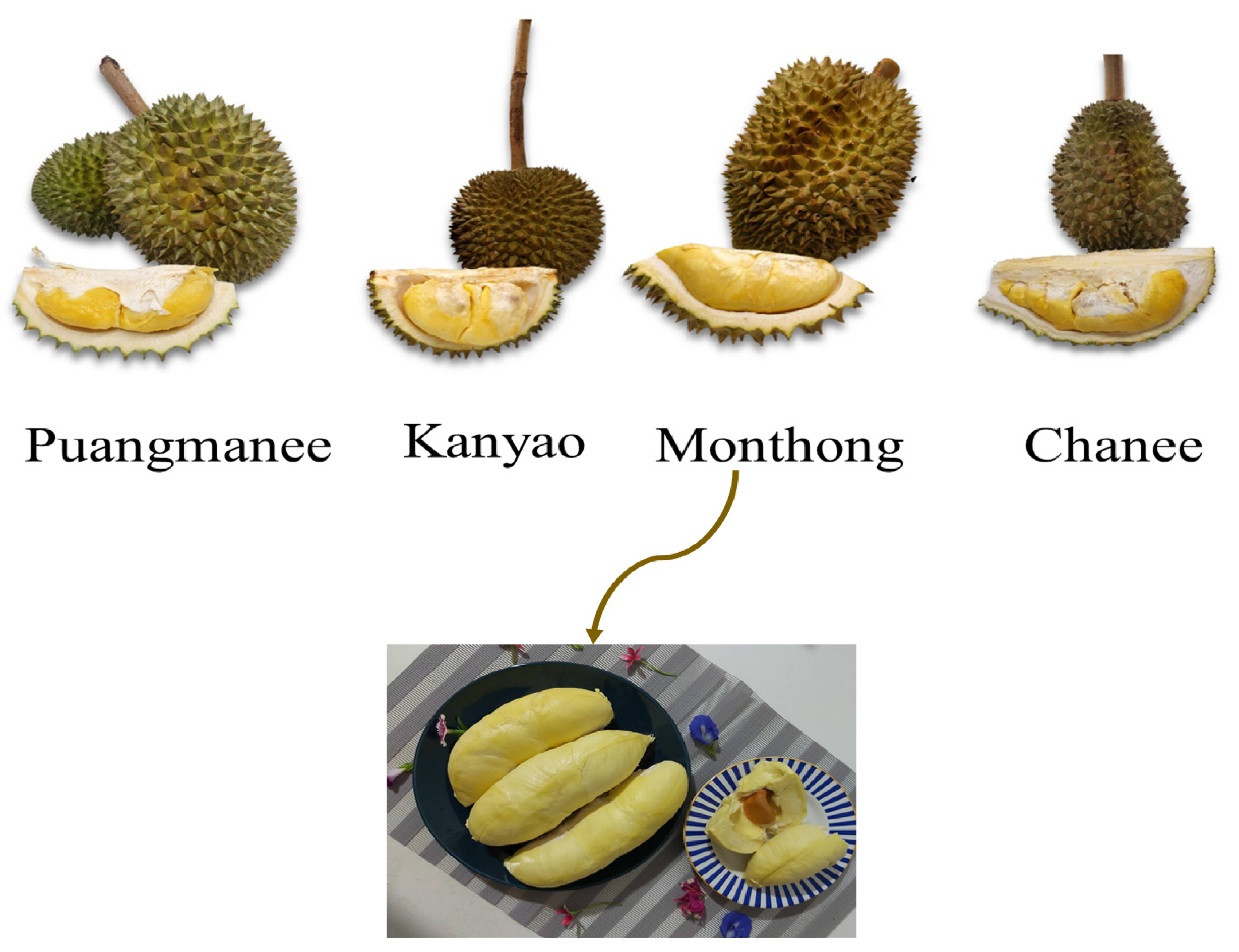


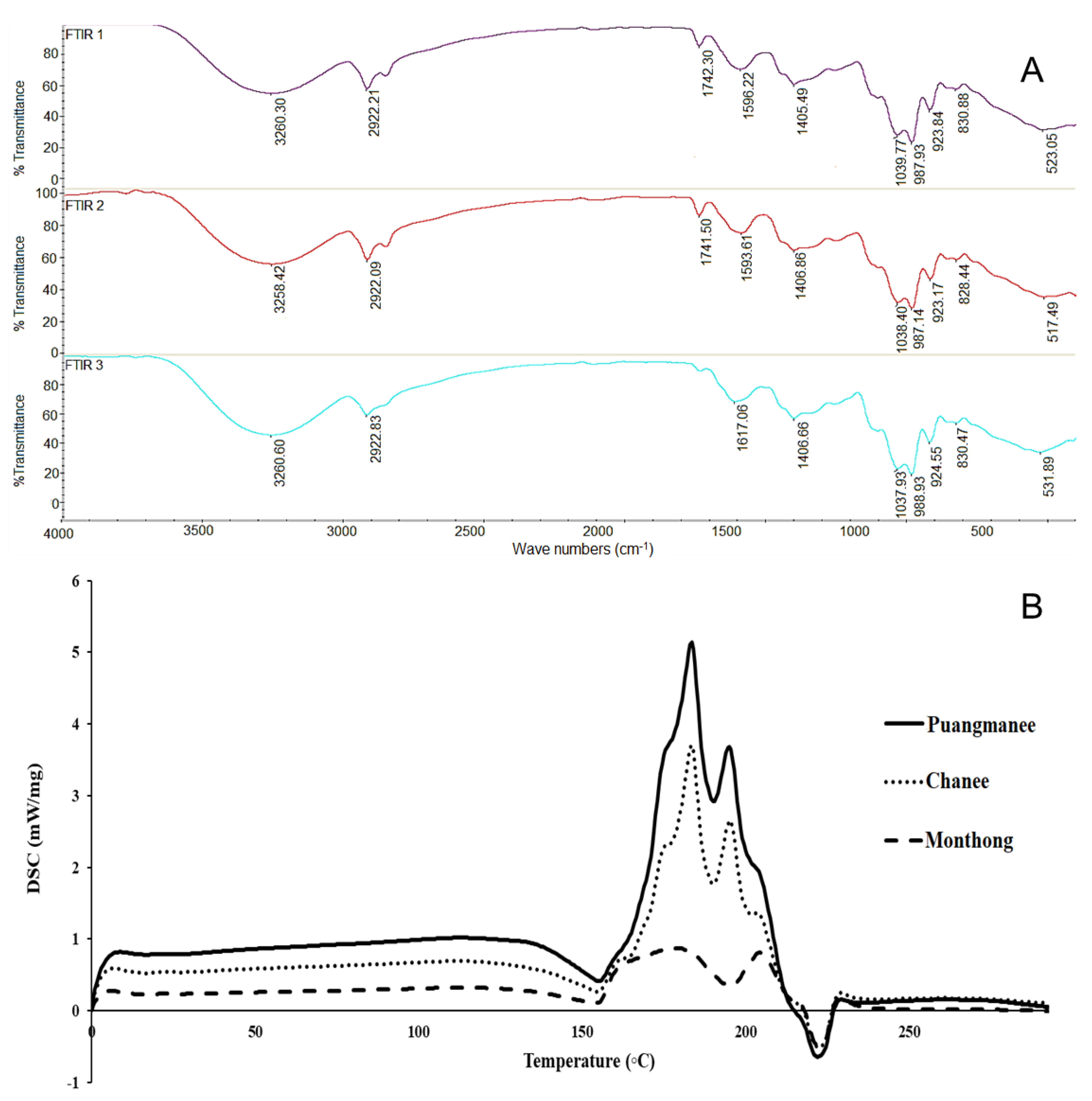
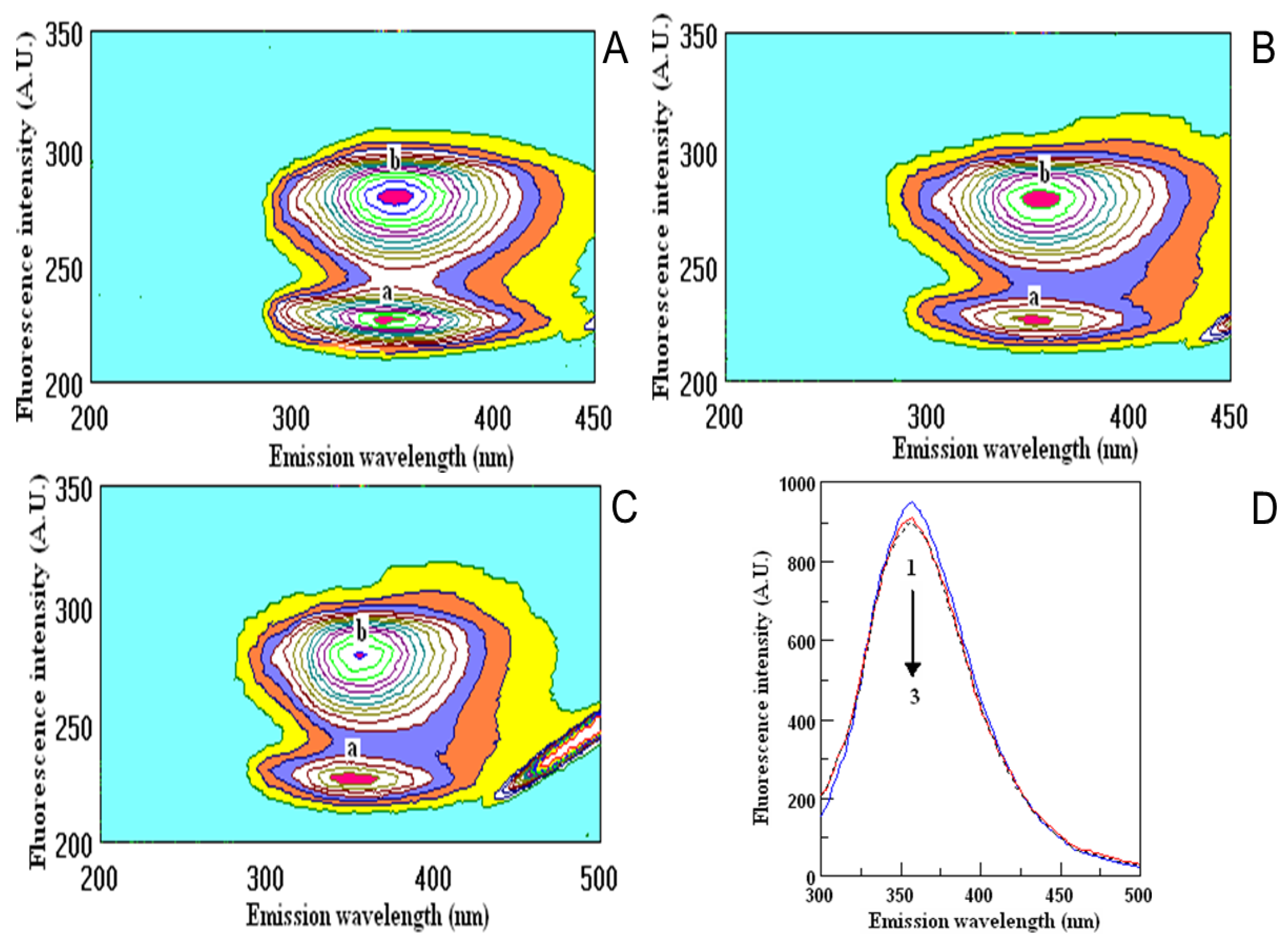
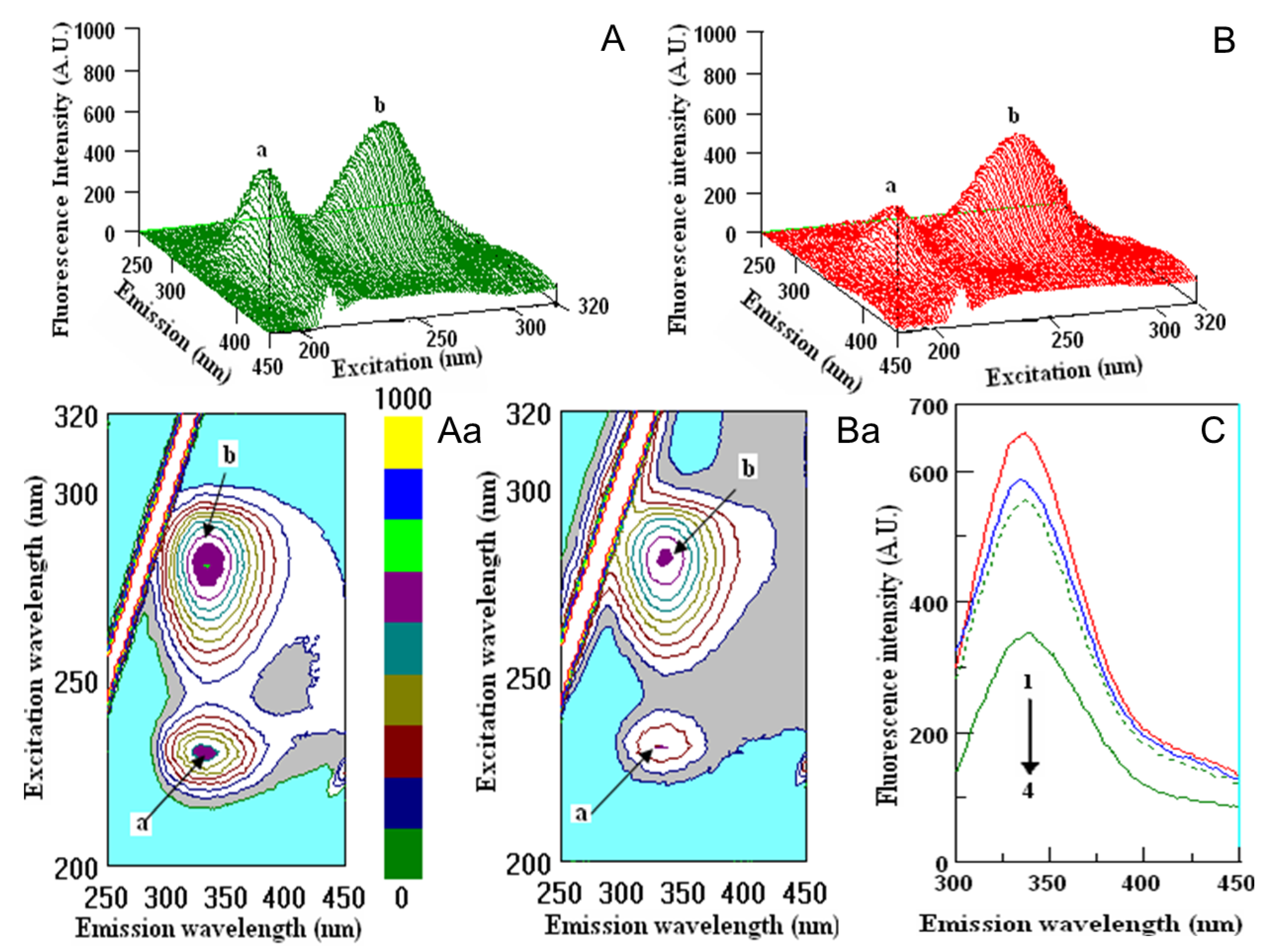
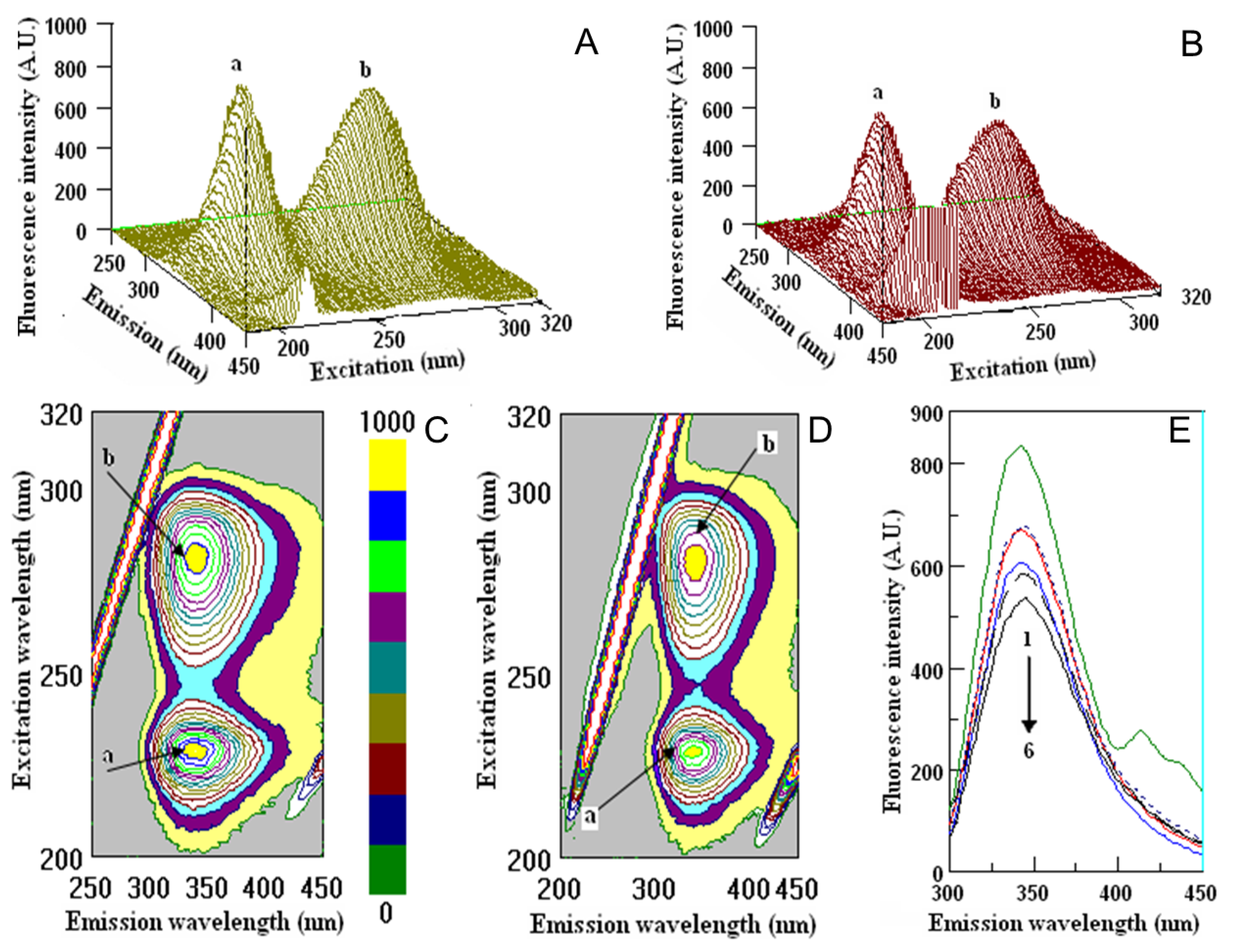
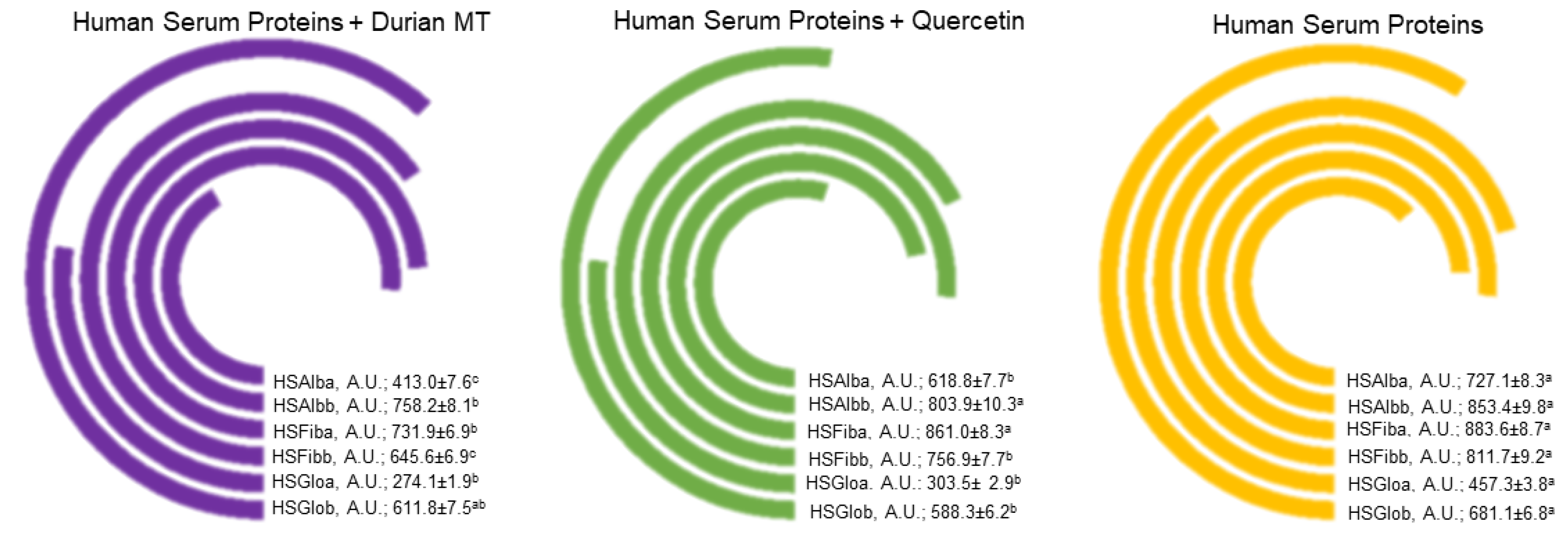
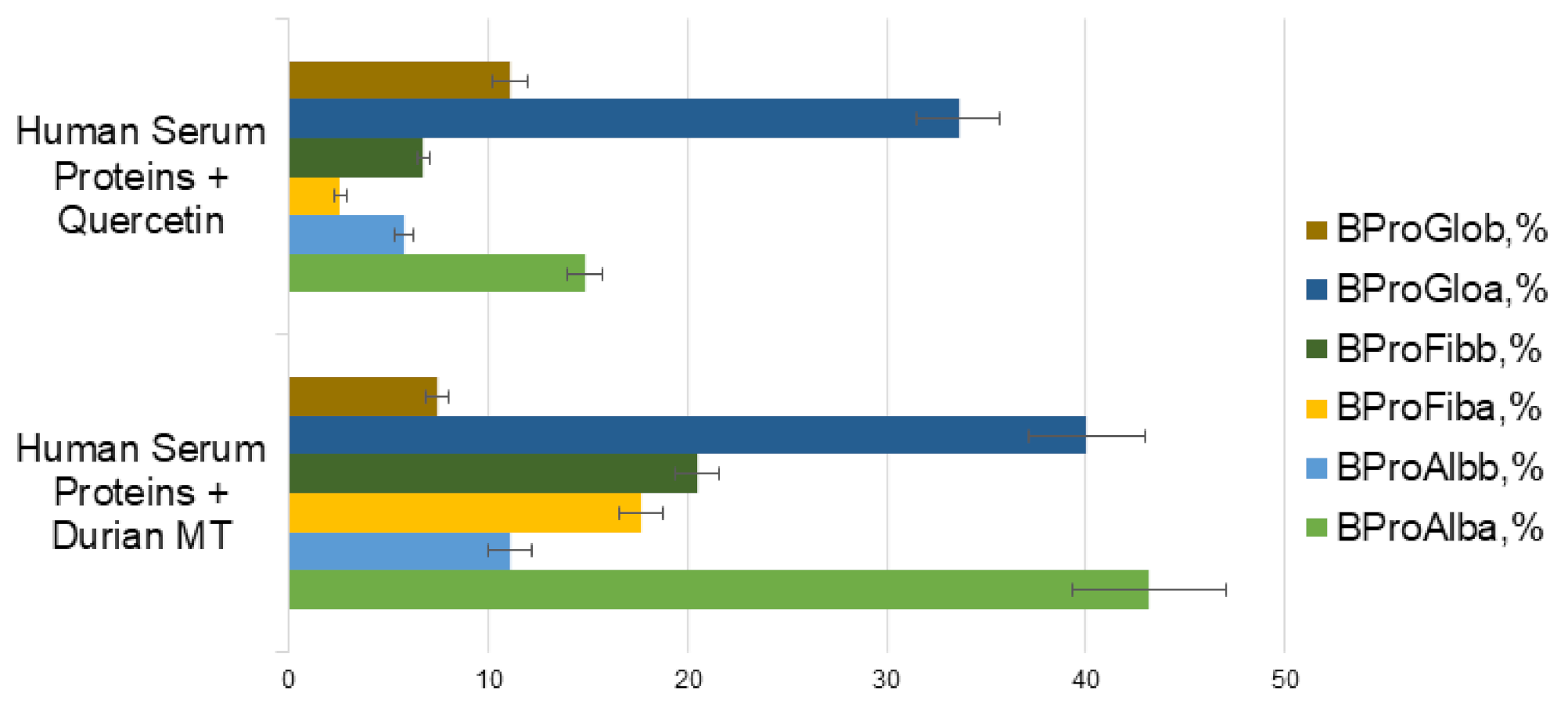
| Cultivars | Maturity Levels (Day) | ||||
|---|---|---|---|---|---|
| Young | Mature | Ripe | Ripe + 1 | Overripe | |
| Monthong | 0 | 5 | 7 | 9 | 10 |
| Chanee | 0 | 4 | 6 | 8 | 10 |
| Kanyao | 0 | 3 | 5 | 7 | 9 |
| Cultivars | Maturity Levels | pH | Acidity (%) | (°Brix) | Total Soluble Solids (%) |
|---|---|---|---|---|---|
| Monthong | Young | 7.08 ± 0.02 a | 0.07 ± 0.00 h | 2.93 ± 0.15 f | 8.80 ± 0.46 f |
| Mature | 6.74 ± 0.03 d | 0.15 ± 0.01 e | 6.77 ± 0.15 d | 20.30 ± 0.46 d | |
| Ripe | 6.76 ± 0.01 d | 0.18 ± 0.01 c,d | 8.33 ± 0.15 c | 25.00 ± 0.46 c | |
| Ripe + 1 | 6.68 ± 0.02 e | 0.20 ± 0.00 a,b | 8.53 ± 0.15 c | 25.60 ± 0.46 c | |
| Overripe | 6.62 ± 0.02 f | 0.21 ± 0.01a | 9.53 ± 0.25 b | 28.60 ± 0.75 b | |
| Chanee | Young | 6.83 ± 0.02 b | 0.13 ± 0.01 f | 5.30 ± 0.10 e | 15.90 ± 0.30 e |
| Mature | 6.67 ± 0.05 e | 0.17 ± 0.01 d,e | 6.80 ± 0.10 d | 20.40 ± 0.30 d | |
| Ripe | 6.61 ± 0.04 f,g | 0.18 ± 0.01 b,c,d | 8.37 ± 0.15 c | 25.10 ± 0.46 c | |
| Ripe + 1 | 6.57 ± 0.03 g | 0.18 ± 0.01 b,c | 8.63 ± 0.15 c | 25.90 ± 0.46 c | |
| Overripe | 6.45 ± 0.01 h | 0.19 ± 0.00 a,b,c | 9.37 ± 0.12 b | 28.10 ± 0.35 b | |
| Kanyao | Young | 6.82 ± 0.02 b,c | 0.11 ± 0.01 g | 5.13 ± 0.12 e | 15.40 ± 0.35 e |
| Mature | 6.77 ± 0.01 c,d | 0.13 ± 0.01 f | 6.93 ± 0.25 d | 20.80 ± 0.75 d | |
| Ripe | 6.74 ± 0.02 d | 0.14 ± 0.01 f | 8.47 ± 0.12 c | 25.40 ± 0.35 c | |
| Ripe + 1 | 6.83 ± 0.03 b | 0.18 ± 0.01 b,c,d | 9.63 ± 0.23 b | 28.90 ± 0.69 b | |
| Overripe | 6.84 ± 0.01 b | 0.18 ± 0.01 b,c,d | 10.63 ± 0.25 a | 31.90 ± 0.75 a |
Publisher’s Note: MDPI stays neutral with regard to jurisdictional claims in published maps and institutional affiliations. |
© 2021 by the authors. Licensee MDPI, Basel, Switzerland. This article is an open access article distributed under the terms and conditions of the Creative Commons Attribution (CC BY) license (https://creativecommons.org/licenses/by/4.0/).
Share and Cite
Arsa, S.; Wipatanawin, A.; Suwapanich, R.; Makkerdchoo, O.; Chatsuwan, N.; Kaewthong, P.; Pinsirodom, P.; Taprap, R.; Haruenkit, R.; Poovarodom, S.; et al. Properties of Different Varieties of Durian. Appl. Sci. 2021, 11, 5653. https://doi.org/10.3390/app11125653
Arsa S, Wipatanawin A, Suwapanich R, Makkerdchoo O, Chatsuwan N, Kaewthong P, Pinsirodom P, Taprap R, Haruenkit R, Poovarodom S, et al. Properties of Different Varieties of Durian. Applied Sciences. 2021; 11(12):5653. https://doi.org/10.3390/app11125653
Chicago/Turabian StyleArsa, Supeeraya, Angkana Wipatanawin, Rachit Suwapanich, Orachorn Makkerdchoo, Niphattha Chatsuwan, Pensiri Kaewthong, Praphan Pinsirodom, Ruchira Taprap, Ratiporn Haruenkit, Sumitra Poovarodom, and et al. 2021. "Properties of Different Varieties of Durian" Applied Sciences 11, no. 12: 5653. https://doi.org/10.3390/app11125653
APA StyleArsa, S., Wipatanawin, A., Suwapanich, R., Makkerdchoo, O., Chatsuwan, N., Kaewthong, P., Pinsirodom, P., Taprap, R., Haruenkit, R., Poovarodom, S., Lubinska-Szczygeł, M., Katrich, E., & Gorinstein, S. (2021). Properties of Different Varieties of Durian. Applied Sciences, 11(12), 5653. https://doi.org/10.3390/app11125653






